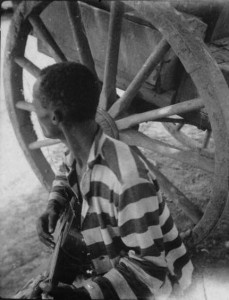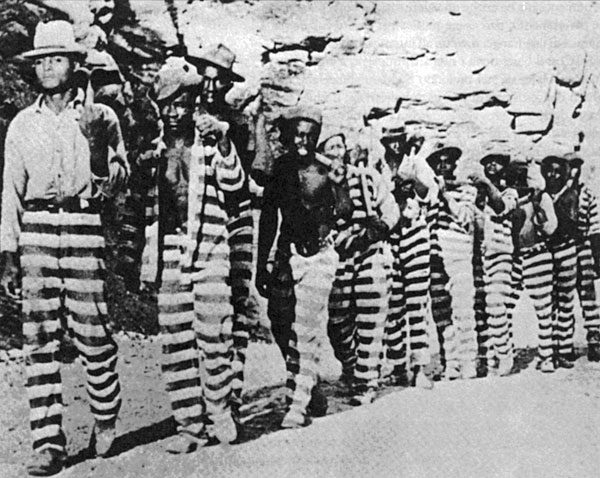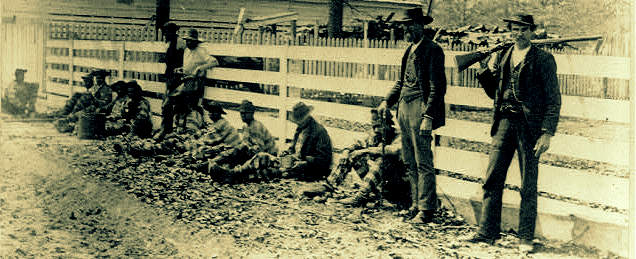
The Convict Lease System
By Ida B. Wells Taken from the third chapter of "The Reason why the colored American is not in the World's Colombian Exposition," published in 1893.

The Convict Lease System and Lynch Law are twin infamies which flourish hand in hand in many of the United States. They are the two great outgrowths and results of the class legislation under which our people suffer to-day. Alabama, Arkansas, Florida, Georgia, Kentucky, Louisiana, Mississippi, Nebraska, North Carolina, South Carolina, Tennessee and Washington claim to be too poor to maintain state convicts within prison walls. Hence the convicts are leased out to work for railway contractors, mining companies and those who farm large plantations. These companies assume charge of the convicts, work them as cheap labor and pay the states a handsome revenue for their labor. Ninetenths of these convicts are Negroes. There are two reasons for this.

(1) The religious, moral and philanthropic forces of the country — all the agencies which tend to uplift and reclaim the degraded and ignorant, are in the hands of the Anglo-Saxon. Not only has very little effort been made by these forces to reclaim the Negro from the ignorance, immorality and shiftlessness with which he is charged, but he has always been and is now rigidly excluded from the enjoyment of those elevating influences toward which he felt voluntarily drawn. In communities where Negro population is largest and these counteracting influences most needed, the doors of churches, schools, concert halls, lecture rooms, Young Men's Christian Associations, and Women's Christian Temperance Unions, have always been and are now closed to the Negro who enters on his own responsibility. Only as a servant or inferior being placed in one corner is he admitted. The white Christian and moral influences have not only done little to prevent the Negro becoming a criminal, but they have deliberately shut him out of everything which tends to make for good citizenship.

To have Negro blood in the veins makes one unworthy of consideration, a social outcast, a leper, even in the church. Two Negro Baptist Ministers, Rev. John Frank, the pastor of the largest colored church in Louisville, Ky., and Rev. C. H. Parish, President of Extein Norton University at Cane Spring, Ky., were in the city of Nashville, Tennessee, in May when the Southern Baptist Convention was in session. They visited the meeting and took seats in the body of the church. At the request of the Association, a policeman was called and escorted these men out because they would not take the seats set apart for colored persons in the back part of the Tabernacle. Both these men are scholarly, of good moral character, and members of the Baptist denomination. But they were Negroes, and that eclipsed everything else. This spirit is even more rampant in the more remote, densely populated plantation districts. The Negro is shut out and ignored, left to grow up in ignorance and vice. Only in the gambling dens and saloons does he meet any sort of welcome. What wonder that he falls into crime?



Twelve men were sentenced to the South Carolina penitentiary on no other finding but a misdemeanor commonly atoned for by a fine of a few dollars, and which thousands of the state's inhabitants (white) are constantly committing with impunity — the carrying of concealed weapons. Fifteen others were sentenced for mere assault and battery. In Louisiana a man was sentenced to the penitentiary for 12 months for stealing five dollars worth of gunnysacks! Out of 2378 convicts in the Texas prison in 1882, only two were under sentence of less than two years length, and 509 of these were under twenty years of age. Mississippi's penitentiary roll for the same year showed 70 convicts between the ages of 12 and 18 years of age serving long terms. Tennessee showed 12 boys under 18 years of age, under sentences of more than a year; and the North Carolina penitentiary had 234 convicts under 20 years of age serving long terms."

Mr. Cable goes on to say in another part of his admirable paper: "In the Georgia convict force only 15 were whites among 215 who were under sentences of more than ten years." What is true of Georgia is true of the convict lease system everywhere. The details of vice, cruelty and death thus fostered by the states whose treasuries are enriched thereby, equals anything from Siberia. Men, women and children are herded together like cattle in the filthiest quarters and chained together while at work. The Chicago Inter-Ocean recently printed an interview with a young colored woman who was sentenced six months to the convict farm in Mississippi for fighting. The costs, etc., lengthened the time to 18 months. During her imprisonment she gave birth to two children, but lost the first one from premature confinement, caused by being tied up by the thumbs and punished for failure to do a full day's work. She and other women testified that they were forced to criminal intimacy with the guards and cook to get food to eat.

The fact that the system puts a large number of criminals afloat in the community from the numerous escapes is not its worst feature. The same report shows that the mortality is fearful in the camps. In one camp it is stated that the mortality is 10 per cent per month, and in another even more than that. In these camps men and women are found chained together, and from twenty to twenty-five children have been born in captivity in the convicts' camps.

Some further facts are cited with reference to the system in use in Tennessee. The testimony of a guard at the Coal Creek prison in Tennessee shows that prisoners, black and dirty from their work in the mines, were put into their rooms in the stockades without an opportunity to change their clothing or sufficient opportunity for cleanliness. Convicts were whipped, a man standing at the head and another at the feet, while a third applied the lash with both hands. Men who failed to perform their task of mining from two to four tons of coal per day were fastened to planks by the feet, then bent over a barrel and fastened by the hands on the other side, stripped and beaten with a strap. Out of the fifty convicts worked in the mines from one to eight were whipped per day in this manner. There was scarcely a day, according to the testimony of the witness, James Frazier, in which one or more were not flogged in this manner for failure to perform their day's task. The work in the mines was difficult and the air sometimes so bad that the men fell insensible and had to be hauled out. Their beds he described as "dirty, black and nasty looking." One of the convicts, testifying as to the kind of food given them, said that the pea soup was made from peas containing weevils and added: "I have got a spoonful of weevils off a cup of soup." In many cases convicts were forced to work in water six inches deep for weeks at a time getting out coal with one-fourth of the air necessary for a healthy man to live in, forced to drink water from stagnant pools when mountain springs were just outside of the stockades, and the reports of the prison officials showing large numbers killed in attempting to escape.

The defense of this prison is based wholly upon its economy to the state. It is argued that it would cost large sums of money to build penitentiaries in which to confine and work the prisoners as is done in the Northern States, while the lease system brings the state a revenue and relieves it of the cost of building and maintaining prisons. The fact that the convicts labor is in this way brought into direct competition with free labor does not seem to be taken into account. The contractors, who get these laborers for 30 or 40 cents per day, can drive out of the market the man who employs free labor at $1 a day.
This condition of affairs briefly alluded to in detail in Tennessee and Georgia exists in other Southern States. In North Carolina the same system exists, except that only able-bodied convicts are farmed out. The death rates among the convicts is reported as greater than the death rate of New Orleans in the greatest yellow fever epidemic ever known. In Alabama a new warden with his natural instincts unblunted by familiarity with the situation wrote of it: "The system is a better training school for criminals than any of the dens of iniquity in our large cities. The system is a disgrace to the state and the reproach of the civilization and Christian sentiment of the age."

Every Negro so sentenced not only means able-bodied men to swell the state's number of slaves, but every Negro so convicted is thereby disfranchised.
It has been shown that numbers of Negro youths are sentenced to these penitentiaries every year and there mingle with the hardened criminals of all ages and both sexes. The execution of law does not cease with the incarceration of those of tender years for petty crimes. In the state of South Carolina last year Mildred Brown, a little thirteen year old colored girl was found guilty of murder in the first degree on the charge of poisoning a little white infant that she nursed. She was sentenced to be hanged. The Governor refused to commute her sentence, and on October 7th, 1892, at Columbia, South Carolina, she was hanged on the gallows. This made the second colored female hanged in that state within one month. Although tried, and in rare cases convicted for murder and other crimes, no white girl in this country ever met the same fate. The state of Alabama in the same year hanged a ten year old Negro boy. He was charged with the murder of a peddler. ()

No comments:
Post a Comment